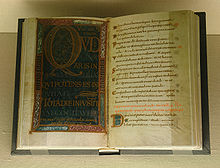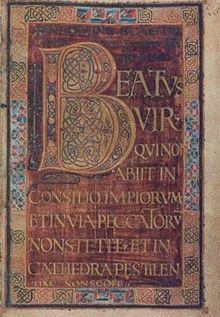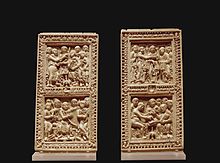Dagulf Psalter

The Dagulf Psalter is a Carolingian illuminated manuscript that contains the Old Testament psalms and the antiphons for recitation in the church hours. The Psalter was written between 783 and 795 in Aachen at the court school of Charlemagne and is considered the most important example of early Carolingian minuscule script .
history
Charlemagne, King of the Franconian Empire at the time and later Emperor, wanted to give the handwritten psalter to Pope Hadrian I (772–795 in office) , as can be seen from a dedicatory poem that preceded it . However, he died before the handover, which is why the psalter remained in imperial possession. The work, also known as the “Golden Psalter” because of its writing technique with golden letters on parchment , was largely copied by a scriptor named Dagulf mentioned in the dedication poem .
In the 11th century, the fate has not been clarified in the meantime, the Psalter came from the bridal treasure of Empress Gisela , wife of Emperor Konrad II , into the possession of the Limburg Monastery . Its abbot Eginhard (1056-1067) was also Bishop of Speyer from 1060 onwards . He had the treasure of the monastery, including the Dagulf Psalter, transferred to Speyer. The list of objects that came to Speyer at that time has been preserved.
As a gift, maybe the former king and later Emperor Henry IV. , The Psalter came under Bishop Adalbert of Bremen at the St. Peter's Cathedral . A reference to this is a text passage in the historical work of Adam of Bremen : “ At that time [end of 1065] the king, out of compassion for the devastated church in Bremen, sent around 100 chasers and other silver vessels, also books, ... a psalter written in gold letters as a replacement ". Since the Psalter contained a dedication to Charlemagne, the book was later taken for a gift from Charlemagne to his first bishop in Bremen, St. Willehad , and treated like a relic . The Psalter was therefore not kept in the cathedral library, but in the treasury. In their directory from around 1420, the book is listed as " a psalter, written and decorated with gold and with two ivory tablets ".
The Golden Psalter remained in the cathedral treasury until the archbishopric was dissolved after the Peace of Westphalia in 1648. Soon afterwards the manuscript came into the possession of Emperor Leopold I in Vienna in an unexplained manner - the book cover with the carved ivory tablets must have already been removed - and is now in the Austrian National Library . The two ivory panels are exhibits from the Louvre .
The Bremen St. Petri-Dom shows a facsimile of the Dagulf Psalter in its museum .
description
The code
The medieval codex comprises 161 sheets of parchment measuring 19.2 × 12 cm. 145 pages are written by the scriptor Dagulf in Carolingian minuscule script with gold tincture. The psalter has three framed initial pages and 150 decorated initials , but no figurative illuminations . The decorative pages are painted with gold ink on purple-colored parchment leaves.
cover
Only the carved, rectangular ivory panels in the format 16.8 × 8.1 cm have survived from the binding. They have different representations in two square fields. The frames are made of carved acanthus .
On the front panel, above: David chooses the psalmists; below: David plays the harp to the psalm song of a choir. In the middle of the acanthus strip, between the two pictures, the Agnus Dei is carved.
On the plaque on the back, above: a clergyman sends the church father Jerome the order from Pope Damasus to rewrite the psalms; below: Hieronymus dictates the edited text. In the middle of the decorative strip, between the two images, the hand of God can be seen.
The earlier edging is no longer there, presumably a silver or gold-plated metal frame mounted on wood with additional decorations.
Individual evidence
- ↑ a b c Dr. Ingrid Weibezahn: Two valuable books in: Treasures from the St. Petri Cathedral in Bremen - Guide through the Cathedral Museum , pages 48–49
- ↑ a b c d e f The large art lexicon by PW Hartmann under the court school of Karls d. Size
- ↑ Keßler, p. 78.
- ^ Gesta Hammaburgensis ecclesiae pontificum III, 45 . In Bernhard Schmeidler (Hrsg.): Scriptores rerum Germanicarum in usum scholarum separatim editi 2: Adam von Bremen, Hamburgische Kirchengeschichte (Magistri Adam Bremensis Gesta Hammaburgensis ecclesiae pontificum). Hanover 1917, p. 187 ( Monumenta Germaniae Historica , digitized version )
- ^ Vienna, Austrian National Library, Cod. 1861 .
- ^ Paris, Louvre, Départements des Objets, d´Art, Inv. 9/10, inv. No. 496
- ↑ a b c d e f Ingrid Weibezahn: Dagulf-Psalter in: Detlev G. Gross (Hrsg.): Treasures from the Bremen St. Petri Cathedral - Guide through the Cathedral Museum . Edition Temmen, Bremen 2005, ISBN 3-86108-540-2 , pp. 86-89.
literature
- Percy Ernst Schramm and F. Mütherich: Monuments of the German Kings and Emperors , Munich 1962, pp. 117–119.
- Paul Lehmann: The medieval cathedral library in Speyer. Munich 1934, p. 5.
- Augustin Keßler: The "treasures" of Limburg . In: Jens Werner: Monastery of the Holy Cross. Limburg . Bad Dürkheim 1993, pp. 78-81.
- Bruno Reudenbach (ed.): Carolingian and Ottonian art (= history of fine arts in Germany, vol. 1), Beck, Munich 2009, pp. 512–513, cat.-no. 275 and 276.
- Stefanie Westphal: Dagulf Psalter. In: Peter van den Brink, Sarvenaz Ayooghi (ed.): Charlemagne - Charlemagne. Karl's art. Catalog of the special exhibition Karls Kunst from June 20 to September 21, 2014 in the Center Charlemagne , Aachen. Sandstein, Dresden 2014, ISBN 978-3-95498-093-2 , pp. 220-223 (with lit.).
Web links
- Dagulfus in the repertory "Historical Sources of the German Middle Ages"
- Catalog and link to the fully digitized version
- More at Earlier Latin Manuscripts

